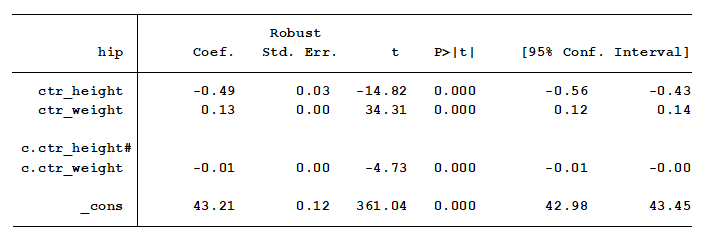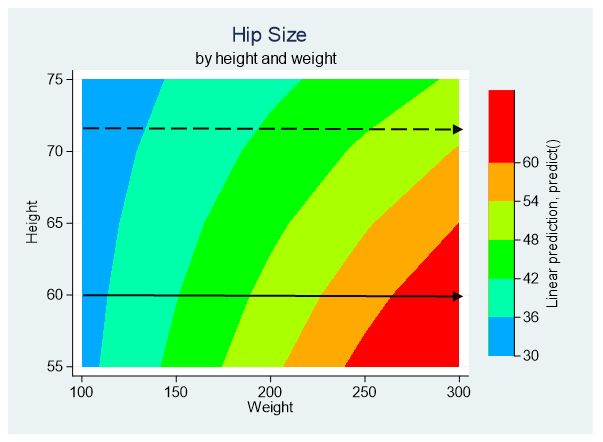Best Way to Show Interaction Effect Two Continuous Variables Figure
What's a good method for interpreting the results of a model with two continuous predictors and their interaction?
Let's start by looking at a model without an interaction. In the model below, we regress a subject's hip size on their weight and height. Height and weight are centered at their means.
Imagine you have a group of people with the same height, but varying weights. Logically we would expect people's hip sizes to be larger if they are heavier. In other words, "keeping height constant, as weight increases, hip size increases".
Likewise, imagine a group of people with the same weight, but varying heights. Logically we would expect hip sizes to be smaller if they are taller (remember, they're all the same weight. For a taller person to be the same weight, they are going to be thinner). This interpretation can be, "keeping weight constant, as height increases hip size decreases.

Indeed, we see these logical results. We see from the output that keeping weight constant, for every one unit increase in height, hip size decreases by 0.48 inches.
In addition, keeping height constant, increasing weight by one pound increases hip size by 0.13 inches.
But this model requires that the effect of increasing weight on hip size is constant at each height. Maybe it's not. Is the change in hip size per one pound change in weight the same for people that are 60 inches tall as it is for people that are 72 inches tall? We need to add an interaction to determine that.

Indeed, we have a small but significant interaction. This tells us that the effect of an additional pound of weight on hip size is not the same for each height.
As height increases each inch, the effect of an additional pound of weight on hip size decreases by .01 inches. But what does that mean?
This is a situation where a graph can be worth a thousand words. Let's graph these results using a contour graph.
The graph below is the predicted hip size for the 403 subjects in the data set. Ranges of predicted hip size are color coded to help interpret the relationship that weight and height have on hip size. The color coded scale is shown on the right side of the graph.

Each color represents a 6" range of predicted values. Blue represents the smallest hip sizes and red represents the largest.
We can see from the graph that the rate of change from one range of hip size to the next is lower for taller people as compared to shorter people.
For example, people who are 60" tall have quickly increasing hip sizes as weight increases a pound. Start at the left side of the graph along the solid line and move to the right as weight increases. Hip sizes quickly go from the blue range (30-36") to green, and on to red (60" plus). So a one-pound increase in weight has a large impact on the hip size of short people.
That's not true for tall people. For example, people who are 72" tall (six feet), move more slowly from one hip size to the next. Start at the left side of the graph along the dashed grey line and move to the right as weight increases. The color bands are wider because a one-pound increase in weight doesn't affect their hip size as much. In fact, people who are taller than 70 inches have a maximum hip size of 54 inches.
Explaining interactions between continuous variables to those not well versed on the subject or understanding them yourself can be a cause for sweaty palms and increased heart rate. But, if you use this visual method for interpretation of your results, your only known side effects will be "a sense of calm and tranquility."
Jeff Meyer is a statistical consultant with The Analysis Factor, a stats mentor for Statistically Speaking membership, and a workshop instructor. Read more about Jeff here.

Four Critical Steps in Building Linear Regression Models
While you're worrying about which predictors to enter, you might be missing issues that have a big impact your analysis. This training will help you achieve more accurate results and a less-frustrating model building experience.
Source: https://www.theanalysisfactor.com/graph-for-interpreting-interaction-continuous-variables/
0 Response to "Best Way to Show Interaction Effect Two Continuous Variables Figure"
Post a Comment